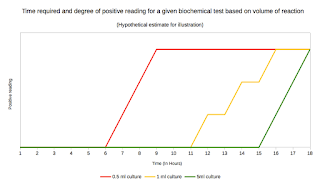Quasi Species: Defending my follow up
Greetings
I had recently posted a post on how do you explain a lot of mutations in sequences from viral outbreaks such as that of Ebola and Influenza (Link). Evidently, some people have misunderstood what I mean to say and there was an aggressive debate on this issue. I was referred to an article in nature news (Link), and my previous blogs on Ebola. I did mention that a lot of mutations are seen in this outbreak, about 300 plus mutations (Link), but I never argued that we are at an accelerated mutation rate and we are evolving more pathogenic strains. It took me sometime to convince the person on other side. Here's my defense argument in a summary. Coincidentally there is a paper right on time, which I can cite.
A new paper in science by Sow etal, has analyzed sequences from the context of Ebola outbreak. The study has analyzed a large set of sequences and determined that nucleotide substitution rate ( 9.6 × 10–4 substitutions per site per year), which is consistent with previous outbreaks. The paper concludes that the virus is not mutating any faster than what it is supposed to be nor is more virulent. As summed up by Sabeti, "We have always been clear that our study only provided data for what everyone already knows that viruses mutate,The data never said that, but it was the way people interpreted the data".
But then the question remains, why are we seeing so many mutations. As I have already argued, virus are a quasi species. More time spent, more are the mutations. Ebola has spread over a very wide geographical area than any other previous outbreak. So in comparison there was a lot of time to have sequence changes. The dendrogram and mutation data depends on the time frame of samples being sequenced, and the number of sequence. This exactly is my point. Virus mutation accumulates overtime. Moreover, the rate of mutation is not the paramount question. It is acquiring a mutation that really translates. And as the paper finds, there are several mutations but nothing that has affected the pathogenesis or significantly of immune interest. Quoting from science, "The new data adds yet more confidence that a vaccine strategy should work he says, because the virus appears fairly stable. So, good news."
Hoenen, T., Safronetz, D., Groseth, A., Wollenberg, K., Koita, O., Diarra, B., Fall, I., Haidara, F., Diallo, F., Sanogo, M., Sarro, Y., Kone, A., Togo, A., Traore, A., Kodio, M., Dosseh, A., Rosenke, K., de Wit, E., Feldmann, F., Ebihara, H., Munster, V., Zoon, K., Feldmann, H., & Sow, S. (2015). Mutation rate and genotype variation of Ebola virus from Mali case sequences Science DOI: 10.1126/science.aaa5646
Vogel, G. (2015). A reassuring snapshot of Ebola Science, 347 (6229), 1407-1407 DOI: 10.1126/science.347.6229.1407





Comments
Post a Comment